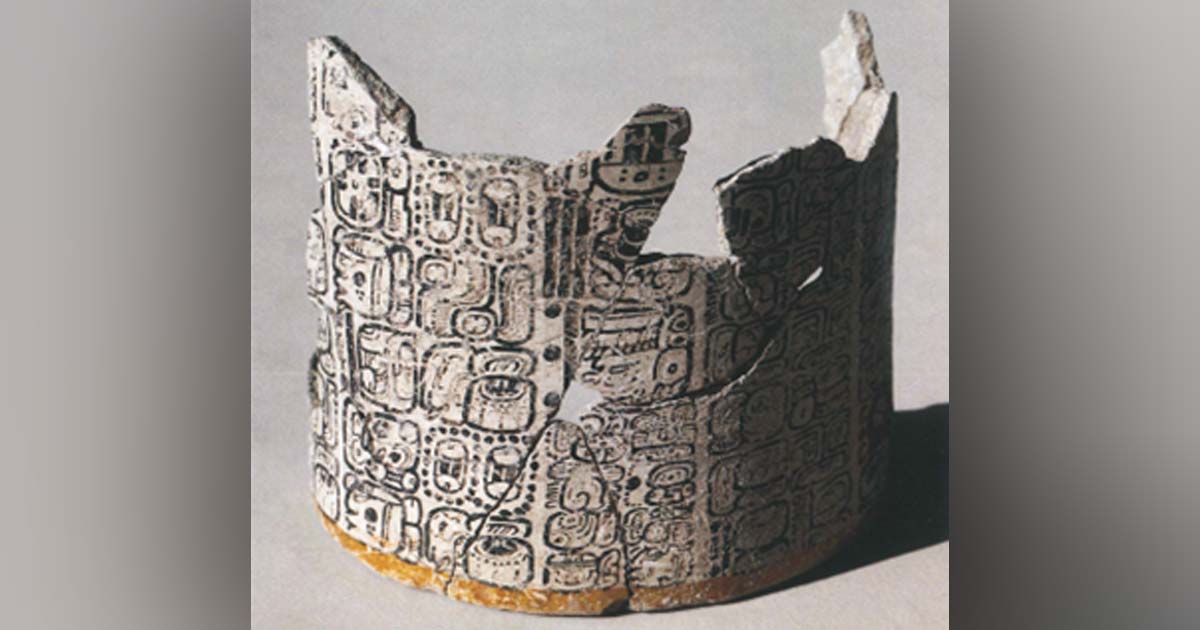Hieroglyphic Vase Reveals Amazing Insights into Maya and Eventual Collapse of Civilization
The discovery of an ancient Maya vase painted with hieroglyphs is the longest Pre-Columbian text ever found in Belize and is offering new information about this once powerful civilization including the reasons for their final demise.
The Maya were one of the most important of all the pre-Columbian civilizations, and their influence is witnessed over a vast region. The shattered vase is now helping us to have a better understanding of its Classical Age.
Baylor University has announced that the find ‘was discovered in excavations directed by Julie Hoggarth, Ph.D., an American archaeologist. She is from the Baylor College of Science and Arts based in Waco, Texas. Hoggarth found the shattered vase and quickly established that it bore important hieroglyphic text. She was so excited that she immediately contacted an expert in Copenhagen, Denmark, to report the discovery.

Fragments of the Komkom Vase showing the A.D. 812 Long Count calendar date. Credit: Baylor University
Maya Baking Pot Site
The artifact was found among a host of other items, including human bones at the Baking Pot site, in the Cayo region of Belize. English explorers gave the site this unusual name after seeing locals boiling chical for gum in large pots when they visited the region in the 16 th century. This is an extensive site that contains a royal place complex, a plaza, ball courts, and many mound houses and was once a major agricultural and ceremonial center. There is no agreement on the reasons as to why Baking Pot was abandoned but civil war and drought have been proposed.
The location is of immense importance because it was occupied by Maya from the Pre-Classical to Post-Classical period (250 AD- 1500 AD). It was still inhabited when many other similar settlements in the Central America Lowlands were abandoned in the Post-Classical period when Maya society was collapsing. According to the Digital Archaeology Record, the site is allowing researchers ‘to learn about abandonment activity in the Maya Lowlands’.

Excavations at Baking Pot, Belize, with team members Claire Ebert of Northern Arizona University, Julie Hoggarth, Ph.D., of Baylor University, and Sean Carr. Credit: Baylor University
Royal Drinking Vessel
It is a multi-colored ceramic vase and it bears the date of 812 AD, and so dates from the Classical period, when Maya Civilization was at its zenith. The vessel was found near the entrance to the Royal Palace and it was shattered into fragments.
It appears to have been thrown into a ceremonial pit as part of a religious ceremony and it was probably then, that it was broken into pieces. After the site was abandoned it appears that large stone slabs from the palace or other buildings fell onto the ceremonial pit.
The vase was probably once a Royal drinking vessel and it was found in an area where commoners were prohibited. When it was intact it was about nine inches tall and based on a study it once had over 200 blocks of hieroglyphic writing. This is remarkable as according to Baylor, this makes it the ‘longest Pre-Columbian text discovered in Belize and among the top 10 longest Classic Period (A.D. 250 to 1000) texts ever discovered’’.
Typically, hieroglyphs were carved on monuments and their characters were quite large. It is very unusual to find so many pictographs on an artifact the size of the vessel. The item was found in 82 fragments. Before experts could really decipher the vase it had to be reconstructed. Researchers took a great deal of time to piece the artifact together, but it is still incomplete and many precious hieroglyphs have been lost.
King Komkom
The vase is telling us much about the history of the area during the Classical period, this is important as the Spanish destroyed the Maya’s records and literature. The writings have revealed that the vessel was owned by a king called Komkom, after whom the vessel is named. It reveals details about wars, diplomacy, ceremonies, and genealogies. In one hieroglyph there is an account of the burning of the Maya centre of Yaxha and the flight of its monarch.
According to Baylor, the writings are mostly “propaganda about royalty” during the Classical period, most Maya rulers were absolute rulers, generally regarded as divine.
Abandonment ritual
It is speculated that the vessel was destroyed when the local Maya were abandoning the site after hundreds of years of occupation. Experts believe that it is likely that this valuable item was destroyed along with other precious items as part of an abandonment ceremony. This was possibly related to the widespread Mesoamerican belief that objects housed spirits and that their destruction leads to the release of a spirit. This would indicate that the local Maya made a conscious decision to abandon the site and that they may have collectively moved to the Highlands, fleeing from war or drought.
The vase was painstakingly studied for many years by a team of researchers. The findings have been published by Hoggarth and two of her colleagues, in ‘“A Reading of the Komkom Vase Discovered at Baking Pot, Belize”. It is hoped that the vase will eventually go on display in a Museum in Belize City.
Top image: Digitized image of the Komkom Vase. Credit: Baylor University
By Ed Whelan



















